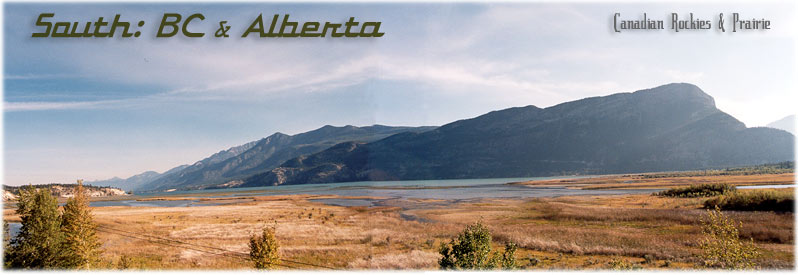 Columbia Lake, British Columbia |
|
|
We
crossed the Continental Divide again, and were in Kootenay National
Park, BC.
We stopped to see the Paint Pots and Ochre beds just west of the Divide. It was a peaceful hike across the Vermilion River with nice mountain views. A pretty, colorful area with clay deposits that were saturated by iron-rich water — thus the warm orange color. Then we came to the "pots" themselves: mineral springs where the iron water has come to the surface. Turning south, we eventually came to the town of Radium Hot Springs. The springs here are popular because they don't have the sulphur odor that most others had. And yes, they are pretty hot and contain radium. The rich folk of the Victorian era used to come because they thought the water had healing powers. (apparently it doesn't) But Peter's uncle and cousin come often to soak in the springs and work on their golf at the nearby courses. We found a hotel; then an outdoor restaurant where I ordered the wrong thing (a unique skill I practice regularly) — a weird meat thing on a patty. The waiter told us about the phenomenon of moderate, even warm temperatures in Radium, in the dead of winter. Then Peter went to play golf before dark and I hobbled into town to look around. A cute place, with nice flowers hanging about, and the Rockies as a nice eastern backdrop. Leaving
Radium, we took 93/95 south and came upon Columbia Lake (above) the
southernmost source of the Columbia River. And soon enough we were going
east through Crow's Nest Pass, another gateway through the Rockies,
and were back in Alberta. Speaking of which, our next destination, about 50 kilometers south on Highway 6, was Waterton Lakes National Park. Its slogan, "Where the mountains meet the prairie" is apt. Just outside of the park was a buffalo paddock, where a nice group roamed freely. We could get close to them, but respected their space. Waterton Lakes N.P. sits just above the US (Montana)/Canada border, and is sort of a partner to Glacier National Park to the south. It's much smaller than the other parks we visited, and unique. The setting of the storybook-like Prince of Wales hotel is stunning, on a hill high above Upper Waterton Lake. The townsite is pretty and charming. There are a couple of routes out into other sections of the park: we took one to Red Rock Canyon. A neat canyon — the color came about when iron sediments on the tidal mud flats were exposed to air and oxidized. There are lighter color sediments running through the red, so there's a great stripe effect. Then it was time to check in with 88-year-old Uncle Oren, who lived in High River, AL. He showed us around the old family homestead, near Vulcan. Peter's father and some of his eight siblings were born there in the 1910-20s. It's a bit worse for wear now, but still has character. We enjoyed this, and touring the prairie. Elegant old grain elevators jut up from the golden flat lands, and are historic monuments of sorts. In the town of Nanton, we found an antique district (much to Oren's surprise and my delight) — fun to look at the Canadian old stuff. (Oren: "I had one of those ... they want 30 dollars for that?") Peter met Oren's sons (his first cousins) for the first time, and they had us over for dinner. It was a nice way to wind down. We were now anxious to get home to the US, to be close to family and friends after all the horrific events. We were lucky to be on the only flight from Calgary to the US on September 15 (after an 8-hour delay). Such a sense of pride and relief when we were back on US soil. But it had been another fantastic Canadian vacation ... I appreciate it even more now, in retrospect. |
Views
from BC & Alberta — click
on images
|
|
Canadian
Rockies & Prairie Main |
|